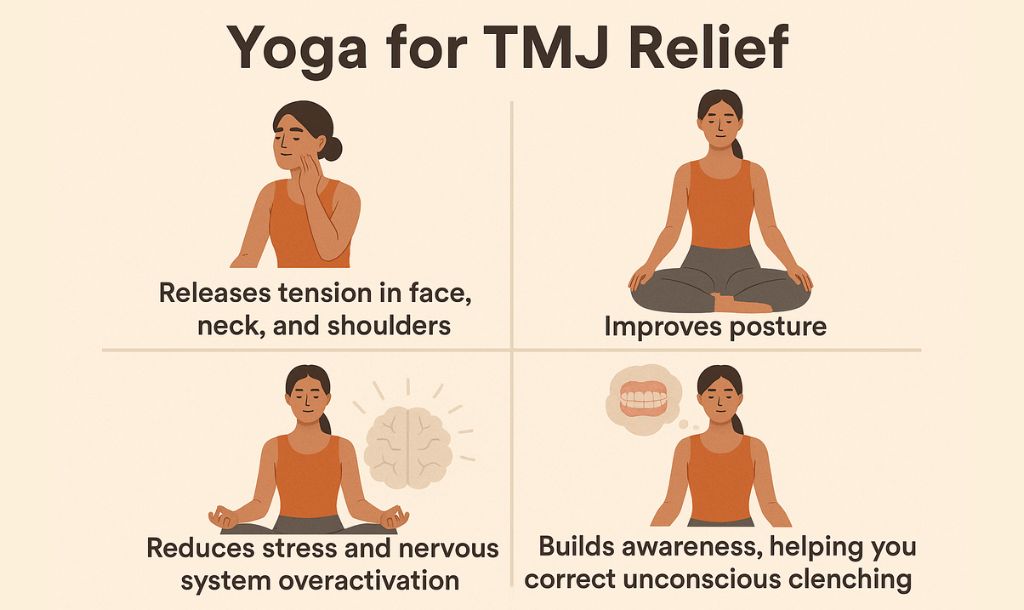What is Puppy Pose (Uttana Shishosana)?
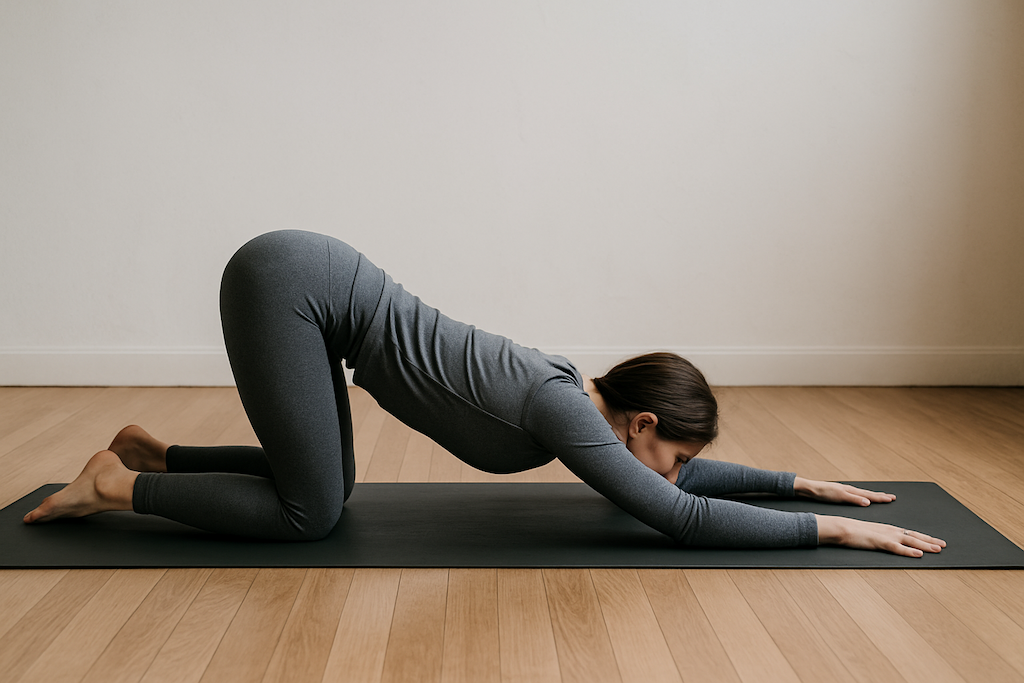
Puppy Pose (Uttana Shishosana) is a gentle kneeling yoga pose that stretches the spine, shoulders, and arms while opening the chest and heart. This beginner-friendly pose combines elements of Child's Pose and Downward Dog, providing a deep upper body stretch that releases tension, improves flexibility, and promotes relaxation.
Also described as a “melting heart” stretch, it allows the chest to gently sink toward the mat, easing tension from long hours of sitting or working at a desk. It’s often practiced as part of gentle yoga, restorative flows, or evening wind-down sequences to relax both the body and the mind.
Puppy Pose: Overview and Meaning Uttana Shishosana
Puppy Pose, or Uttana Shishosana, combines the Sanskrit words uttana (extended stretch), shisho (puppy), and asana (pose). Also called Anahatasana or Melting Heart Pose, it mirrors a playful puppy stretching forward, inviting openness, surrender, and gentle heart-centered release.
Though not described in classical yoga texts, Puppy Pose emerged in modern yoga as teachers began incorporating animal-inspired stretches and restorative movements. Inspired by the way animals instinctively extend their spines, this posture stretches the upper and mid-back, shoulders, and arms while engaging the core, hip flexors, and quadriceps. The knees, shins, forehead (or chin), and palms provide grounding, creating space across the chest, restoring posture, and counteracting stiffness from prolonged sitting or forward rounding. Its heart-lowering position also promotes surrender, mindfulness, and mental calm, reflecting traditional yoga principles of humility and inner awareness.
Today, Puppy Pose is widely used in Yin and Restorative yoga, transitional sequences, and cool-down flows. It’s especially helpful for desk workers or anyone needing upper-back, neck, and shoulder relief. Gentle yet active, it’s a safe, accessible posture for beginners building mobility and developing breath awareness.
At A Glance:
- Sanskrit Name: उत्तान शिशोसन (Uttana Shishosana)
- Pronunciation: oo-TAH-nah shee-SHO-sah-nah
- English Name: Puppy Pose, Extended Puppy Pose, Melting Heart Pose
- Pose Type: Gentle backbend, heart-opening stretch
- Level: Beginner-friendly
- Duration: 30 seconds to 3 minutes
Benefits of Puppy Pose (Uttana Shishosana)
Puppy Pose offers one of the most comprehensive upper-body stretches in yoga. It releases deep-seated tension across the shoulders, neck, and upper spine — areas where many of us hold stress from sitting or hunching forward for long hours.
Some of the many benefits include:
Physical Benefits
- Improves posture: This gentle spinal stretch helps release tightness in the thoracic region (mid-back), improving posture and relieving stiffness from desk work.
- Opens tight shoulders: Perfect for reversing forward shoulder rounding caused by computer or phone use. The pose increases range of motion in the shoulders and arms.
- Relieves upper back pain: By allowing the chest to sink toward the mat, Puppy Pose helps decompress the space between the shoulder blades, easing chronic tension in the upper back.
- Improves arm mobility: The reach through the arms targets the latissimus dorsi and triceps, improving mobility for reaching, lifting, or overhead movements.
- Gentle heart-opener: Encourages chest expansion without the strong backbend often required in deeper poses like Wheel or Camel.
- Mild hip flexor stretch: Keeping the hips aligned over the knees lightly opens the front of the hips, providing balance to the upper body stretch.
- Releases neck tension: When the forehead rests on the mat rather than the chin, the neck muscles relax completely, offering relief from stiffness or strain.
Mental and Emotional Benefits
- Soothes the nervous system: The mild inversion (head lowering) encourages blood flow to the brain and signals the body to relax.
- Reduces stress and anxiety: Combining deep breathing with gentle movement helps quiet the mind and ease emotional tension.
- Improves sleep quality: Practicing this pose in the evening, especially with longer holds, can help calm racing thoughts and prepare the body for rest.
- Encourages emotional release: The “melting heart” quality of the pose often brings a sense of surrender, allowing emotional heaviness to lift.
- Increases mindfulness: Extended holds teach patience, breath awareness, and the ability to be present — skills that carry into daily life.
Therapeutic Applications of Puppy Pose
- Desk work recovery: An ideal counterpose to the slumped posture of working at a computer, this pose lengthens the spine and resets shoulder alignment.
- Athletic recovery: Beneficial for swimmers, climbers, and anyone involved in overhead activities to maintain shoulder flexibility.
- Mild anxiety reduction: Deep chest breathing in this pose activates the parasympathetic nervous system, promoting relaxation.
- Shoulder conditioning (with caution): When practiced gently and correctly, it can aid shoulder mobility for those managing impingement or stiffness.
How to Do Puppy Pose (Uttana Shishosana): Step-by-Step Guide
Part 1: Preparing for Puppy Pose
Before easing into Puppy Pose, it’s important to warm up your spine and shoulders — the two areas most engaged in this posture.
1. Tabletop Pose (Bharmanasana)
This neutral position builds the foundation for arm-supported poses like Puppy Pose by aligning the spine and activating stabilizing muscles.
- Place your hands and knees on the mat with wrists directly below shoulders and knees below hips.
- Spread your fingers wide, pressing evenly through your palms.
- Keep your spine neutral — neither arching nor rounding — and engage your core slightly.
- Hold for a few breaths, maintaining even weight between hands and knees.
2. Cat–Cow Pose (Marjaryasana–Bitilasana)
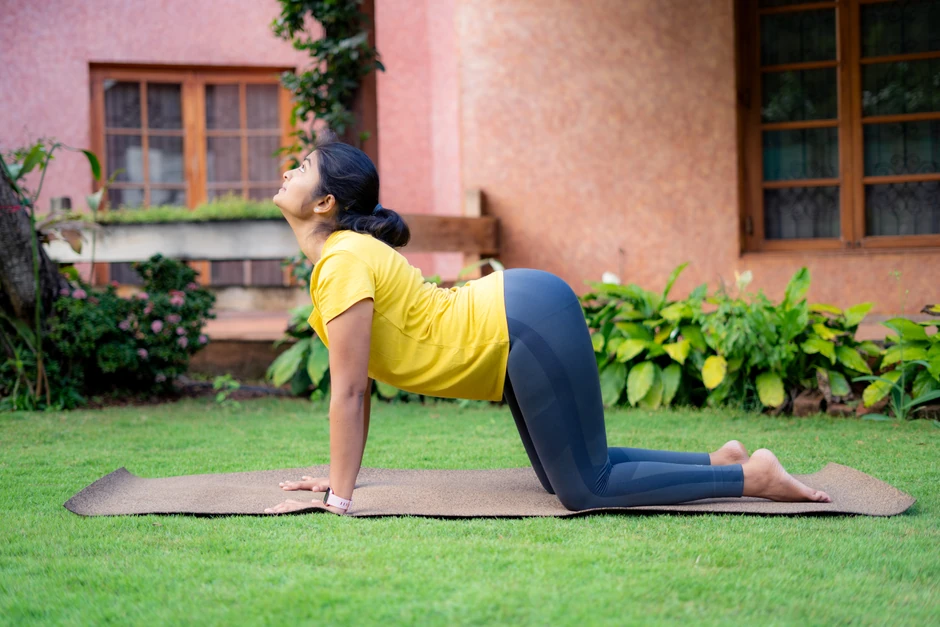
The flowing movement improves spinal flexibility, eases stiffness, and connects breath with movement.
- Begin on your hands and knees in Tabletop position, wrists under shoulders and knees under hips.
- Inhale as you drop your belly, lift your chest, and gaze slightly upward (Cow Pose).
- Exhale as you round your spine, drawing your navel toward your spine and tucking your chin (Cat Pose).
- Continue moving with your breath for 5–8 rounds.
3. Plank Pose (Phalakasana)
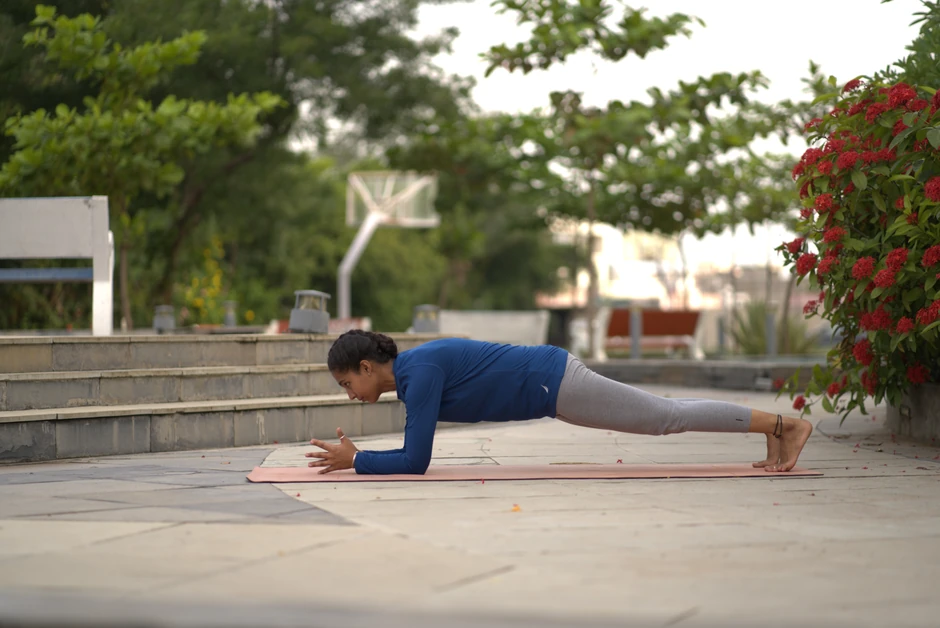
This pose activates shoulder and core muscles, promoting controlled strength and alignment before deeper stretches.
- From Tabletop, step your feet back one at a time until your body forms a straight line from head to heels.
- Engage your core and press your palms firmly into the mat, keeping your shoulders above your wrists.
- Draw your shoulder blades slightly down your back to avoid collapsing in the chest.
- Hold for 20–30 seconds, breathing steadily.
Part 2: How to do Puppy Pose: Step‑by‑Step Instructions
- Place your wrists under your shoulders and knees under your hips. Keep your spine long and gaze slightly down to align the neck.
- Exhale and slowly walk your hands toward the top of your mat. Keep your hips stacked above your knees — do not shift them backward like in Child’s Pose.
- Allow your chest and forehead to melt gently toward the floor.
- Keep your arms extended with palms pressing lightly into the mat.
- Feel a stretch from your hips to your fingertips.
- Gently draw your lower belly in to support your spine.
- Take slow, steady breaths, allowing your chest to expand with each inhale and your upper back and shoulders to open naturally with each exhale.
- Stay in the pose for 5–10 deep breaths (30–60 seconds).
- To exit, gently walk your hands back toward your body and return to Tabletop.
Part 3: Alignment and Safety Tips
- Keep your hips over your knees—avoid letting them drop back toward the heels.
- If your forehead doesn’t reach the mat, rest it on a yoga block, folded towel, or cushion.
- For a deeper stretch, rest your chin on the mat instead of your forehead (skip this if it strains the neck).
- Relax your shoulders away from your ears.
- Keep elbows off the mat; arms stay active and engaged.
- Always move slowly — this is a heart-opening, not a power pose.
Learn Puppy Pose step-by-step with a coach. Book a free 1-on-1 session today!
Puppy Pose Variations
While Puppy Pose is deeply relaxing on its own, exploring variations can make it more accessible, restorative, or challenging — depending on what your body needs on a given day.
These variations help target specific muscle groups and support different wellness goals like shoulder mobility, relaxation, or posture correction.
1. Supported Puppy Pose (Restorative Variation)
This pose gently releases shoulder and back tension, supports deep breathing, and is great for winding down before bedtime.
- Place a bolster or two folded blankets lengthwise at the center of your mat.
- As you move into Puppy Pose, rest your chest and torso on the bolster.
- Let your forehead or one cheek rest to the side for comfort.
- Relax your arms on the floor or alongside the bolster.
2. Extended Puppy Pose (Deep Shoulder Opener)
This pose stretches the shoulders, triceps, and upper chest while preparing you for deeper backbends.
- From Tabletop, walk your hands farther forward until your arms are fully straight.
- Lift your elbows and engage the upper arms to keep them active.
- Let your chin (instead of your forehead) rest lightly on the mat to intensify the chest opening.
3. Forearms-on-Blocks Puppy Pose
This pose relieves pressure from the neck and shoulders and allows gradual deepening as flexibility improves. It is an excellent modification for anyone recovering from shoulder stiffness.
- Place yoga blocks under your forearms at medium height.
- Keep elbows shoulder-width apart and palms facing each other.
- Sink the chest gently toward the mat without force.
4. Thread-the-Needle Puppy Pose
This pose adds a gentle twist through the spine and shoulders, enhances spinal flexibility, and relieves neck tightness.
- From standard Puppy Pose, thread your right arm under your left arm, palm facing up.
- Rest your right shoulder and ear on the mat.
- Press lightly into your left palm to deepen the twist.
- Repeat on the other side.
5. Wall-Supported Puppy Pose
This pose is ideal for office or home practice. It also boosts shoulder mobility for those who work long hours at a computer.
- Stand about 2 feet from a wall.
- Place your palms on the wall at shoulder height, then walk backward, hinging at the hips.
- Keep your hips stacked over your feet and let your chest move toward the floor.
Puppy Pose: Precautions and Contraindications
While gentle and beginner-friendly, it’s still important to practice Puppy Pose with care, especially if you have joint issues or back concerns. Understanding your body’s limits helps you gain maximum benefit without strain.
Here’s what to keep in mind before practicing:
Avoid if You Have:
- Shoulder Injuries or Pain: The deep shoulder stretch can aggravate injuries like rotator cuff tears or impingement.
- Neck Sensitivity: If the neck feels compressed when lowering the chin or forehead, support the head with a folded blanket.
- Knee Pain or Recent Surgery: The weight on bent knees may cause discomfort.
- Severe Lower Back Pain: Engaging the core is crucial in this posture. If you struggle to maintain neutral spine support, consult a teacher before practicing.
- Hip Tightness or Replacements: Keep the hips elevated and avoid overextending to prevent pressure on the joints.
- Vertigo or Blood Pressure Balances: The mild inversion can feel dizzying for some — rise slowly and always prioritize comfort.
Precautionary Tips for Safe Practice
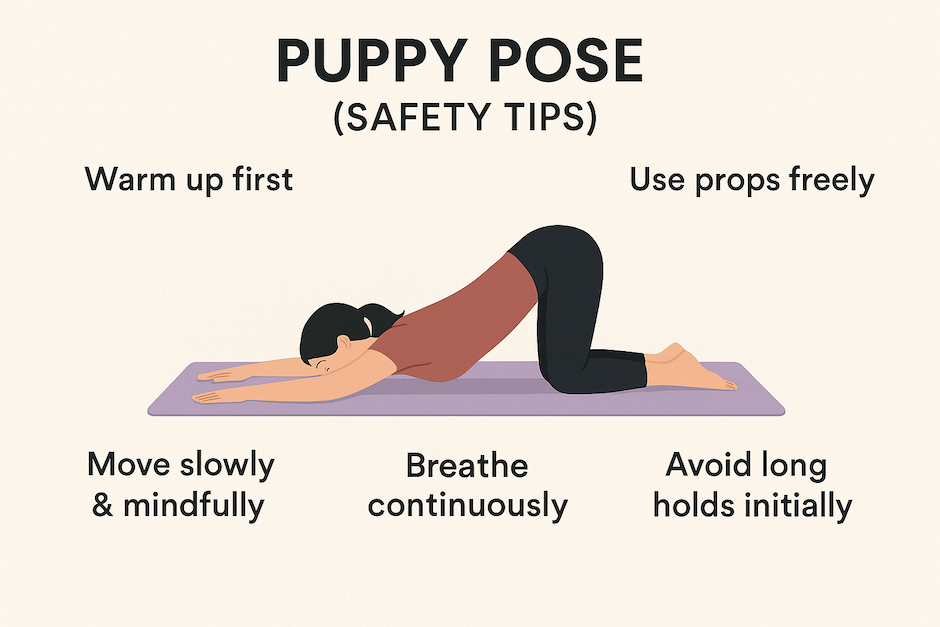
- Warm up first: Begin with gentle movements like Cat-Cow or seated shoulder rolls. Warm muscles are less prone to strain.
- Use props freely: Blocks, bolsters, or cushions under the chest, head, or forearms can transform this pose into a restorative stretch.
- Keep movements slow and mindful: Never drop the chest too quickly — focus on breath-led extensions rather than forcing flexibility.
- Breathe continuously: Holding your breath creates upper body tension. Use long, relaxed breaths to deepen safely.
- Avoid long holds initially: Begin with 3–5 deep breaths; gradually extend as comfort grows.
To practice with maximum safety, book a free 1-on-1 session today!
Puppy Pose (Uttana Shishosana): Related Yoga Poses
Puppy Pose bridges gentle relaxation and active stretching. If you enjoy its calming shoulder-opening effects, these related poses can help you build flexibility, back strength, and mindful alignment:
1. Child’s Pose (Balasana)
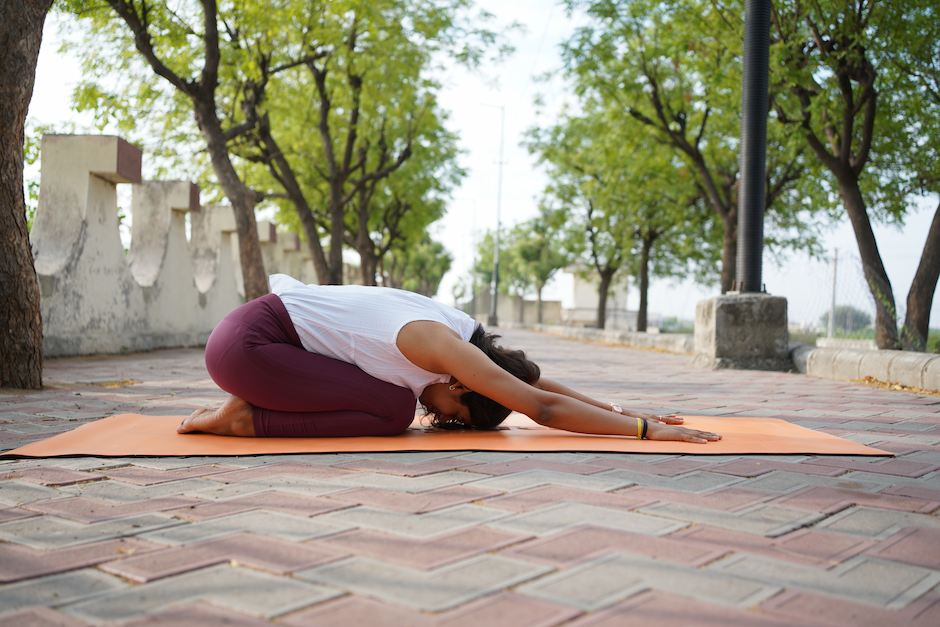
Grounds the body and relieves lower back and hip tension.
- Kneel on your mat with knees together or wide apart, sitting back on your heels.
- Fold forward, resting your forehead on the mat or a block.
- Stretch your arms forward or rest them alongside your body, palms up.
- Breathe deeply and stay for 5–10 breaths.
2. Downward-Facing Dog (Adho Mukha Svanasana)
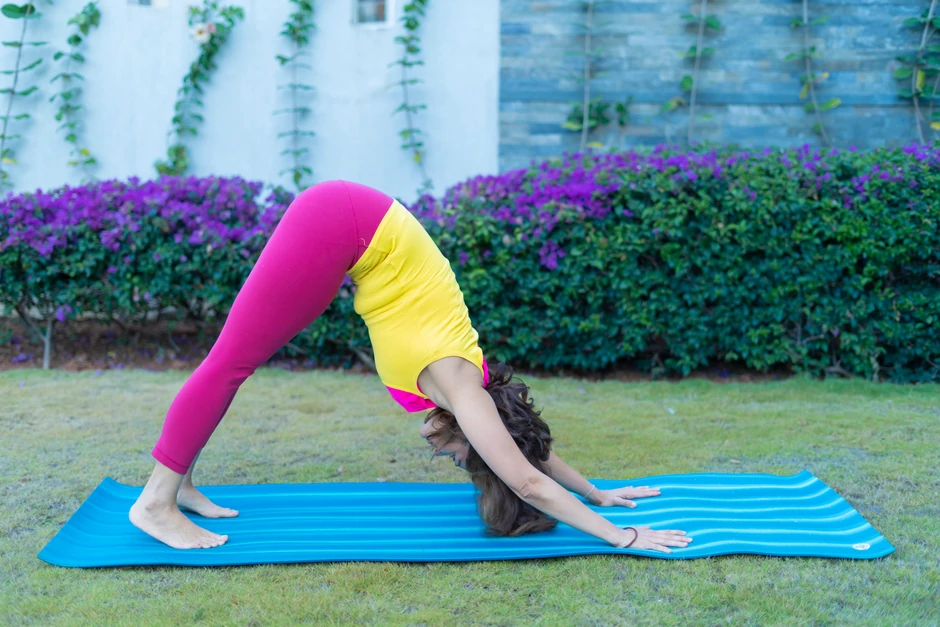
Stretches the spine, hamstrings, and shoulders dynamically.
- From tabletop, tuck your toes under and lift your hips toward the ceiling, forming an inverted V.
- Spread your fingers wide and press evenly through your palms.
- Keep your spine long and heels reaching toward the mat (bend knees if needed).
- Hold for 5–10 breaths, keeping shoulders away from ears and chest open.
3. Cat-Cow Pose (Marjaryasana–Bitilasana)
Enhances spinal mobility and warms up the back.
- Begin in a tabletop with wrists under shoulders and knees under hips.
- Inhale: drop your belly, lift your chest, gaze slightly upward (Cow Pose).
- Exhale: round your spine, tuck your chin (Cat Pose).
- Continue flowing with your breath for 5–8 rounds.
4. Sphinx Pose (Salamba Bhujangasana)
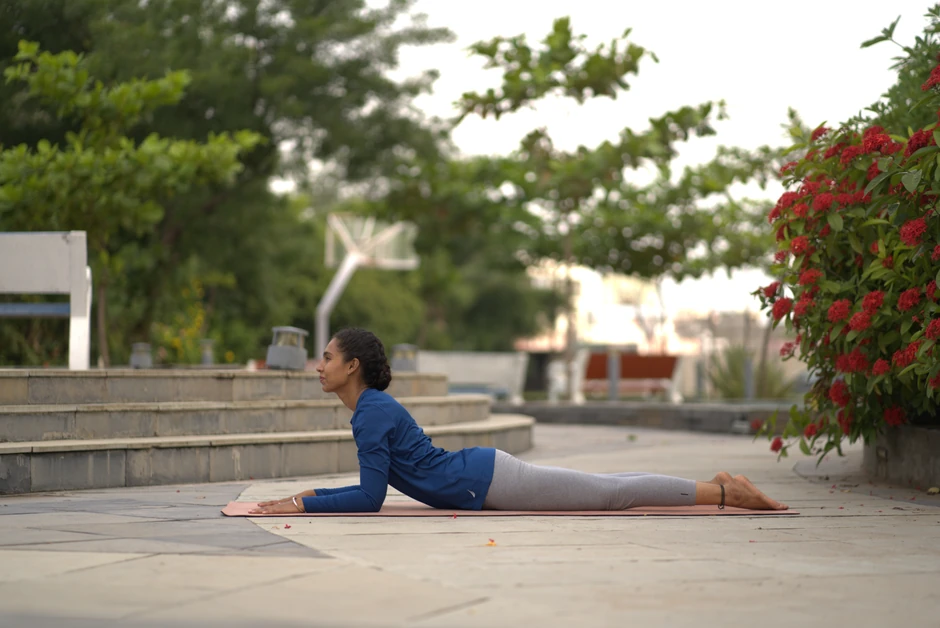
Strengthens the spine and opens the chest gently.
- Lie on your stomach with legs extended and the tops of the feet pressing into the mat.
- Place your elbows under your shoulders and forearms on the floor.
- Lift your chest and draw your shoulders back without compressing the lower back.
- Breathe deeply and hold for 5–10 breaths.
5. Melting Heart Pose (Anahatasana)
Deepens heart opening and shoulder stretch while promoting relaxation.
- Begin on all fours, walk your hands forward while keeping your hips over your knees.
- Lower your chest toward the mat and rest your forehead or chin down.
- Keep arms extended, palms pressing lightly, feeling a stretch across the chest and shoulders.
- Breathe deeply and stay for 5–10 breaths, focusing on gentle release.
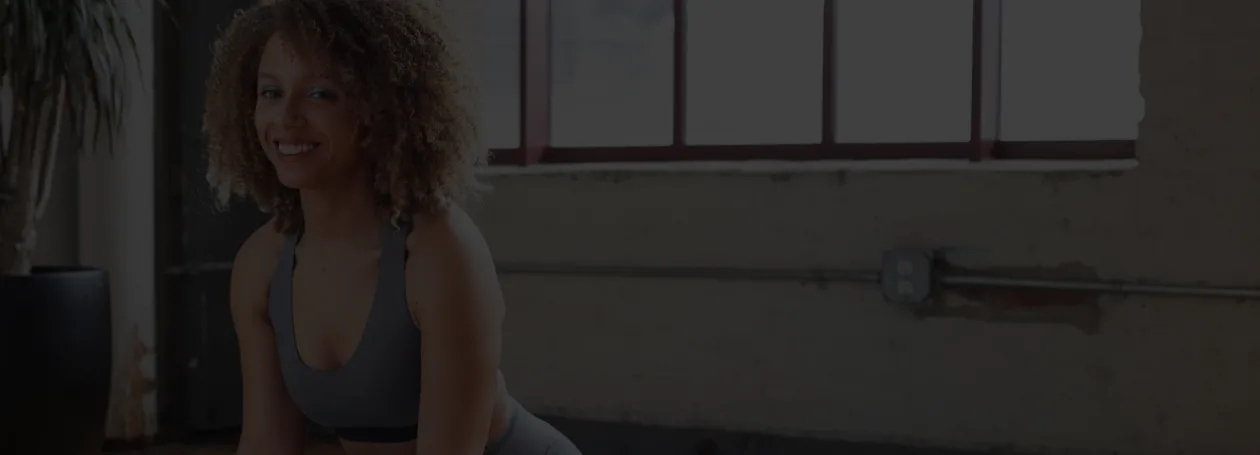
Enjoy a Free 1-on-1 Session with a Coach!
Receive personalized guidance tailored to your unique fitness goals, live with a dedicated coach—no credit card required.
Frequently Asked Questions
Yes! Puppy Pose is one of the best beginner-friendly yoga poses. It offers a gentle stretch for the shoulders, spine, and chest — without requiring deep flexibility. Beginners can always use props like a bolster or folded blanket under the chest for extra comfort.
Puppy Pose helps relieve upper back stiffness, improve posture, and calm the mind. It opens the shoulders and chest — especially helpful if you sit at a desk for long hours. Many practitioners also find it grounding for reducing stress and anxiety.
Yes, when done with awareness. Engage your core and avoid collapsing your ribs toward the floor to protect your lower back. If you already have back pain, practicing under a certified yoga coach ensures proper alignment and safety.
Start with 3–5 slow breaths and gradually increase as your body allows. The goal isn’t duration — it’s to maintain a steady, relaxed breath and avoid any strain. Over time, you can hold for up to a minute for a deeper effect.
Both are relaxing forward bends, but their focus differs:
- Puppy Pose keeps the hips above the knees to stretch the shoulders and upper back.
- Child’s Pose rests the hips on the heels and releases lower back tension.
They complement each other beautifully in a balanced practice.
Avoid or modify if you have:
- Shoulder injuries
- Knee discomfort
- Severe back pain
- Vertigo or high blood pressure issues
Always listen to your body and, when in doubt, ask a yoga teacher for guidance — especially if you’re new or recovering from discomfort.


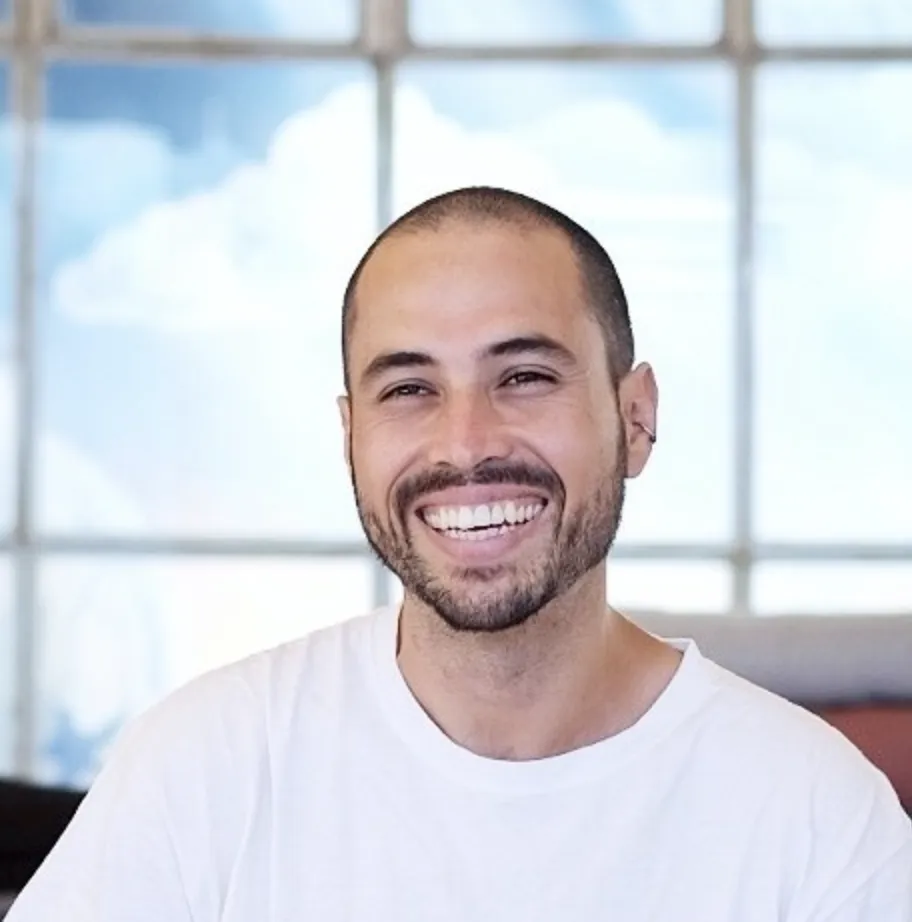
.webp)
%20(7).jpg)
